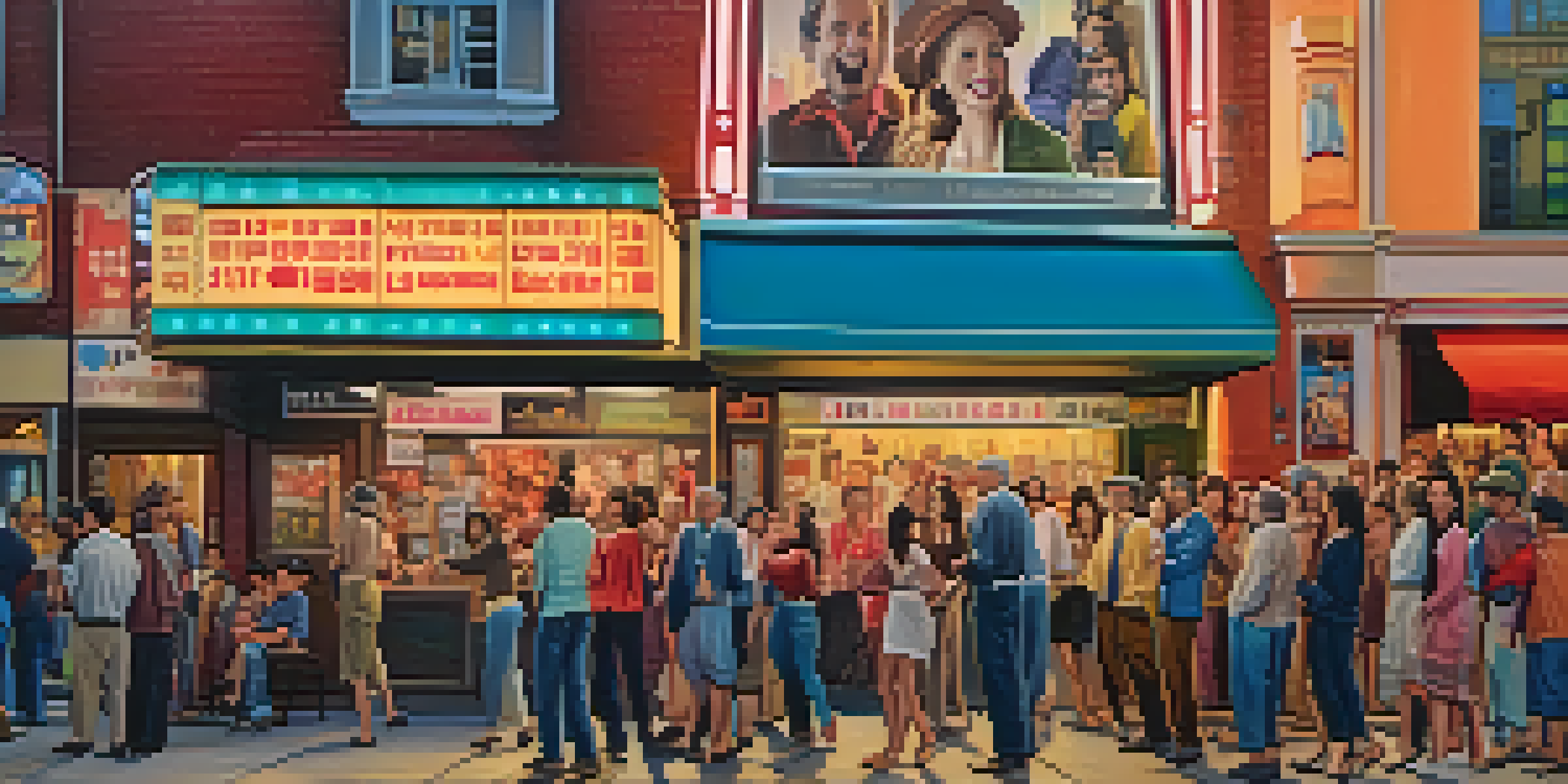How Satire in Film Reflects Society and Engages Audiences

Understanding Satire: A Tool for Reflection
Satire is a powerful form of expression that uses humor, irony, and exaggeration to critique societal norms and behaviors. By presenting familiar situations in a ludicrous light, filmmakers can shine a spotlight on the absurdities of life. Think of films like 'Dr. Strangelove,' where the ridiculousness of nuclear war is laid bare, prompting audiences to reconsider their own beliefs.
Satire is a sort of glass, wherein beholders do generally discover everybody's face but their own.
This blend of entertainment and critique allows viewers to engage with complex issues without feeling overwhelmed. Instead of being lectured, audiences laugh and reflect, making the message more palatable. This clever approach can lead to a deeper understanding of serious topics, encouraging viewers to think critically about their own realities.
Ultimately, satire invites dialogue. When people leave the theater chuckling or shaking their heads, they often find themselves discussing the underlying themes and messages, fostering a richer conversation about society's flaws.
Historical Context: Satire through the Ages
Satire has a long history in literature and the arts, dating back to ancient Greece. Filmmakers have drawn inspiration from this rich tradition, using it to comment on contemporary issues. For instance, Charlie Chaplin's 'The Great Dictator' satirized fascism during a time of global turmoil, making a poignant statement about human rights.

As society evolves, so do the themes explored in satirical films. The transition from black-and-white classics to today’s colorful blockbusters illustrates how filmmakers adapt their messages to resonate with current audiences. Modern films like 'The Interview' tackle political satire, reflecting ongoing tensions in global politics.
Satire as a Reflection Tool
Satire uses humor and irony to engage audiences in critical conversations about societal norms and issues.
By examining the historical context of satire in film, we can better appreciate how filmmakers respond to the societal challenges of their time. Each generation brings its own issues to the forefront, ensuring that satire remains relevant and impactful.
The Mechanics of Satire: Techniques and Tropes
Filmmakers employ various techniques to create effective satire, including parody, caricature, and absurdity. Parody mimics the style of a specific genre or work to highlight its flaws, while caricature exaggerates characteristics to emphasize certain traits. These techniques allow audiences to recognize the underlying commentary while enjoying the humor.
The role of satire is to make the comfortable uncomfortable.
Absurdity is another powerful tool in the satirist's arsenal. By presenting outrageous scenarios, filmmakers challenge viewers' perceptions of reality. For example, in 'Monty Python's Life of Brian,' the absurdity of religious zealotry is laid bare, prompting audiences to reflect on their beliefs and practices.
These techniques not only entertain but also provoke thought. By blending humor with critical observation, satirical films encourage viewers to question societal norms and expectations, creating a lasting impact long after the credits roll.
Satire and Social Issues: A Mirror to Reality
One of the most compelling aspects of satire is its ability to address pressing social issues. Films like 'Get Out' tackle racism and cultural appropriation, using satire to highlight uncomfortable truths. By exaggerating real-life scenarios, filmmakers can prompt audiences to confront biases they may not even realize they hold.
Additionally, satirical films often expose the absurdity of societal structures, such as in 'The Hunger Games,' where class disparity is critiqued through a dystopian lens. This allows viewers to see their own world reflected back at them, often sparking conversations about inequality and justice.
Historical Evolution of Satire
Satire has evolved from ancient traditions to modern films, adapting to address contemporary societal challenges.
By engaging with these themes, satire becomes a catalyst for change. It empowers audiences to question the status quo and consider their role in shaping a more equitable society.
Audience Engagement: Laughing through Discomfort
Satire has a unique ability to engage audiences by blending humor with discomfort. This combination encourages viewers to laugh at the absurdities of life while simultaneously grappling with serious issues. For instance, many people find themselves chuckling uncomfortably at the outrageous elements in films like 'Borat,' which tackle sensitive subjects like cultural differences and xenophobia.
This kind of engagement helps break down barriers, allowing audiences to discuss topics they might otherwise avoid. The humor serves as a buffer, making it easier to approach challenging conversations about race, gender, and politics. In this way, satire fosters a more open dialogue about societal issues.
When audiences leave the theater, they often carry with them not only the laughter but also the lingering thoughts and questions raised by the film. This engagement can lead to reflection and, ultimately, a desire for change.
Modern Satire: Digital Age and New Mediums
With the rise of the digital age, satire has found new platforms and expressions, notably in social media and streaming services. Memes, short videos, and web series have democratized satirical content, allowing anyone with a smartphone to participate in the conversation. Shows like 'Saturday Night Live' and 'Last Week Tonight with John Oliver' have adapted to this new landscape, reaching wider audiences than ever before.
This shift has also allowed for more immediate reactions to current events, as satirical content can be produced and shared rapidly. This immediacy means that filmmakers and comedians can respond to societal events almost in real-time, keeping their commentary fresh and relevant. The viral nature of social media also amplifies their reach, ensuring that satirical messages resonate widely.
Engagement through Humor and Discomfort
Satirical content encourages audiences to confront uncomfortable truths while laughing at the absurdities of life.
As we navigate this new terrain, it's essential to recognize the role of modern satire in shaping public discourse. It continues to reflect societal issues while engaging audiences in ways that traditional media may struggle to achieve.
The Future of Satire in Film: Challenges and Opportunities
Looking ahead, the future of satire in film is both exciting and challenging. As societal issues evolve, filmmakers must find innovative ways to address complex topics while still entertaining their audiences. This balancing act requires a keen understanding of the audience's sensitivities and the ability to navigate cultural shifts.
Moreover, the rise of cancel culture poses new challenges for satire. Filmmakers must tread carefully, ensuring that their humor does not cross into harmful territory. However, this challenge also presents an opportunity for growth, as creators can push boundaries and encourage conversations about what is acceptable in comedy.

Ultimately, the future of satire in film will depend on its ability to adapt and resonate with audiences. By remaining true to its roots while embracing new forms of expression, satire can continue to be a powerful tool for reflection and engagement in society.